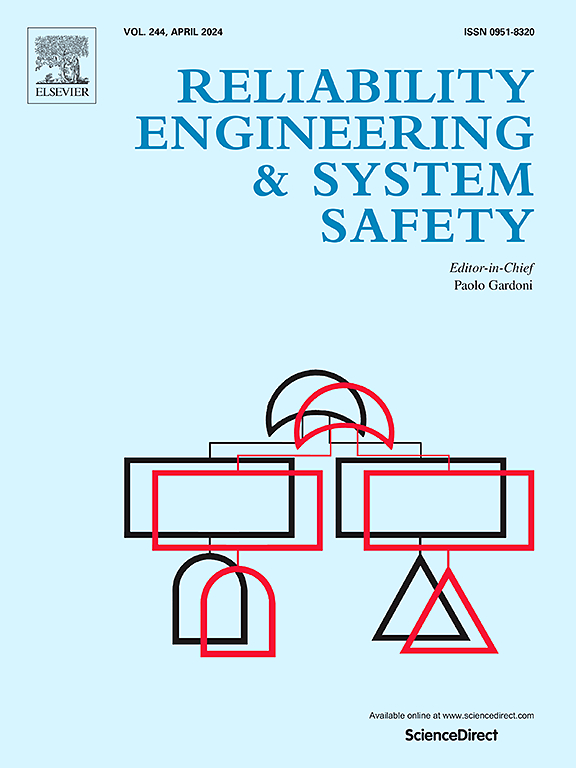Modelling collision risk between container and fishing ships during cross encounter in a cordon area
IF 9.4
1区 工程技术
Q1 ENGINEERING, INDUSTRIAL
引用次数: 0
Abstract
Collisions between container ships and fishing ships frequently result in significant consequences, particularly in China. To assess the collision risk of ship cross-meetings in the warning area, this study constructed a collision risk model using historical AIS data. The risk influencing factors included relative distance, relative speed, relative bearing, distance closest point of approach (DCPA) and time closest point of approach (TCPA). We extracted pairs of trajectories of ships of different types (container ships and fishing ships) and employed the entropy approach to calculate the weights of each risk factor for the modelling of collisions between two ships in real time. Our findings indicate that the collision risk during a two-ship cross-meeting increases gradually as the meeting progresses, reaching a maximum value (approximately 0.66) at the point of nearest proximity, after which it decreases. A comparison and analysis of the three areas revealed that the warning area represented a high-risk area for the cross-meeting. In order to calculate the weight value of each ship and assess the real-time collision risk during the multi-ship cross-meeting, the Shapley value method was employed. The results indicate that the collision risk of a multi-ship encounter is significantly higher than that of a two-ship encounter. Furthermore, the change in risk values is more complex. This study not only quantifies the risk between two ships, but also provides a new method to quantify the risk of multiple ships. This provides important theoretical support for the safety of ship navigation.
警戒线区域内集装箱与渔船交叉碰撞风险建模
集装箱船和渔船之间的碰撞经常造成严重后果,特别是在中国。为了评估预警区域船舶交叉碰撞的风险,本研究利用AIS历史数据构建了碰撞风险模型。影响风险的因素包括相对距离、相对速度、相对方位、距离最近进场点(DCPA)和时间最近进场点(TCPA)。我们提取了不同类型船舶(集装箱船和渔船)的轨迹对,并采用熵值法计算了各风险因素的权重,用于实时建立两船碰撞模型。研究结果表明,两船相遇时的碰撞风险随着相遇的进行而逐渐增加,在最接近的点达到最大值(约0.66),之后降低。对三个区域的比较分析表明,预警区域是交叉会议的高风险区域。为了计算每艘船的权重值,评估多船交叉碰撞时的实时碰撞风险,采用了Shapley值法。结果表明,多船相遇的碰撞风险显著高于双船相遇的碰撞风险。此外,风险值的变化更为复杂。本研究不仅量化了两船之间的风险,而且为多船风险的量化提供了一种新的方法。这为船舶航行安全提供了重要的理论支持。
本文章由计算机程序翻译,如有差异,请以英文原文为准。
求助全文
约1分钟内获得全文
求助全文
来源期刊

Reliability Engineering & System Safety
管理科学-工程:工业
CiteScore
15.20
自引率
39.50%
发文量
621
审稿时长
67 days
期刊介绍:
Elsevier publishes Reliability Engineering & System Safety in association with the European Safety and Reliability Association and the Safety Engineering and Risk Analysis Division. The international journal is devoted to developing and applying methods to enhance the safety and reliability of complex technological systems, like nuclear power plants, chemical plants, hazardous waste facilities, space systems, offshore and maritime systems, transportation systems, constructed infrastructure, and manufacturing plants. The journal normally publishes only articles that involve the analysis of substantive problems related to the reliability of complex systems or present techniques and/or theoretical results that have a discernable relationship to the solution of such problems. An important aim is to balance academic material and practical applications.
 求助内容:
求助内容: 应助结果提醒方式:
应助结果提醒方式:


